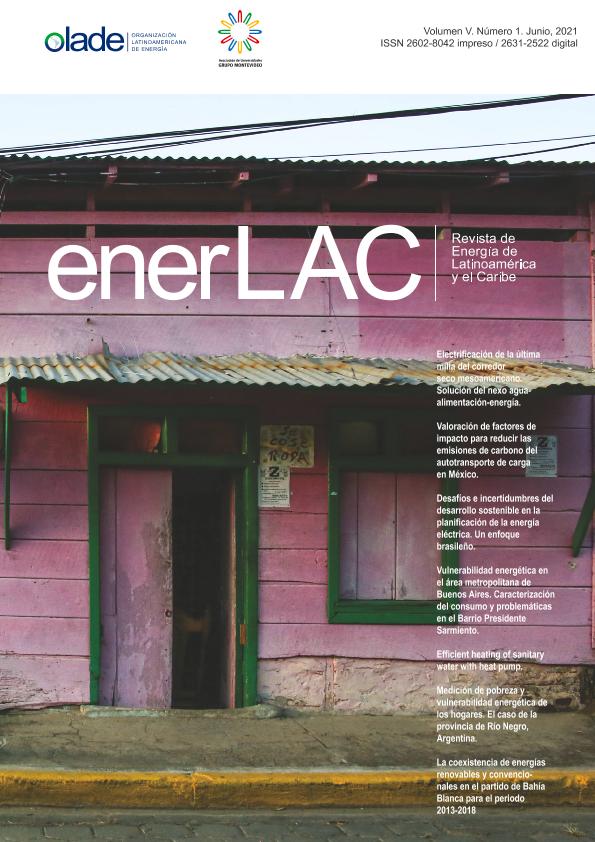Artículo
En Latinoamérica existen innumerables barrios populares en donde la provisión de energía es irregular. El conocimiento de cuánto y cómo se consume en estos barrios es escaso y necesario para generar políticas de inclusión. Por tanto, son objetivos de esta contribución cuantificar el consumo de un barrio popular, comparar este consumo con la media del sector residencial de la zona a la que pertenece y, finalmente, caracterizar su vulnerabilidad energética. En el Área Metropolitana de Buenos Aires, el barrio Presidente Sarmiento está compuesto de 1,174 viviendas distribuidas en 52 edificios semejantes lo que lo convierte en un apropiado sitio de estudio. En 2018, un censo consultó por la presencia o ausencia de 15 artefactos en las viviendas. A partir de esta base de datos, valores de macromediciones eléctricas y relevamientos en territorio se elaboró un modelo que permitió analizar la distribución de los consumos del barrio, caracterizar los usos finales y detectar problemas de vulnerabilidad energética. Se obtuvo que las viviendas del barrio consumen en promedio 12,395 kWh/año, valor levemente inferior que la media de la región. Pese a que, en general, no abonan por la energía, al menos un 17% de las viviendas registra un severo déficit de calefacción y agua caliente sanitaria. In Latin America, there are countless popular neighborhoods where energy supply is irregular. In order to generate inclusion policies in these neighborhoods it is highly necessary to collect information about the amount and the way in which energy is consumed. However, this type of data is normally scarce. Therefore, the aims of this paper are to quantify the consumption, to compare it with the average of the residential sector in the area to which it belongs, and to characterise its energetic vulnerability. Presidente Sarmiento neighborhood located in Buenos Aires Metropolitan Area consists of 1,174 apartments distributed in 52 similar buildings, which makes it an appropriate study site. In 2018, a population census gathered data about the existence of 15 energy artifacts in these houses. This database together with electrical macro measurement values and surveys made in the territory was used to develop a model that allowed analyzing the distribution of consumption in the neighborhood, characterizing end uses and detecting energy vulnerability problems. It was found that dwellings in this neighborhood consume an average of 12,395 kWh/year, slightly lower than the average for the region. Despite the fact that, at large they do not pay for the energy supply, at least 17% of the apartments has a severe deficiency in heating and sanitary hot water, which is their main energy use.
Vulnerabilidad energética en el Área Metropolitana de Buenos Aires: Caracterización del consumo y problemáticas en el Barrio Presidente Sarmiento
Título:
Energy vulnerability in the Metropolitan Area of Buenos Aires: Characterization of consumption and problems in the presidente sarmiento neighborhood
Fecha de publicación:
06/2021
Editorial:
Organización Latinoamericana de Energía
Revista:
enerLAC
ISSN:
2602-8042
e-ISSN:
2631-2522
Idioma:
Español
Tipo de recurso:
Artículo publicado
Clasificación temática:
Resumen
Archivos asociados
Licencia
Identificadores
Colecciones
Articulos (IRNAD)
Articulos de INSTITUTO DE INVESTIGACIONES EN RECURSOS NATURALES, AGROECOLOGIA Y DESARROLLO RURAL
Articulos de INSTITUTO DE INVESTIGACIONES EN RECURSOS NATURALES, AGROECOLOGIA Y DESARROLLO RURAL
Citación
Briaturi, Mauricio Agustín; Quesada, Agustín; Villarreal, Agustín; Mirochnik, Guillermo; Vulnerabilidad energética en el Área Metropolitana de Buenos Aires: Caracterización del consumo y problemáticas en el Barrio Presidente Sarmiento; Organización Latinoamericana de Energía; enerLAC; 5; 1; 6-2021; 76-93
Compartir




